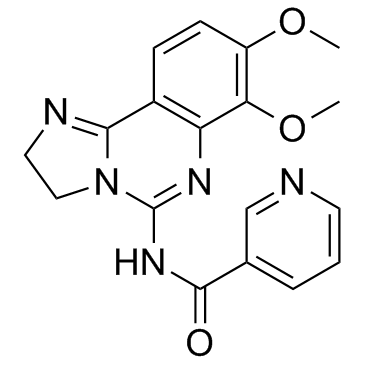677338-12-4
| Name | N-(7,8-dimethoxy-2,3-dihydroimidazo[1,2-c]quinazolin-5-yl)pyridine-3-carboxamide |
|---|---|
| Synonyms |
1-Oxa-6-azacyclopentadecan-15-one, 11-[(3-amino-3,4,6-trideoxy-β-D-xylo-hexopyranosyl)oxy]-13-[(2,6-dideoxy-3-C-methyl-3-O-methyl-α-L-ribo-hexopyranosyl)oxy]-2-ethyl-3,4,10-trihydroxy-3,5,6,8,1 0,12,14-heptamethyl-, (2R,3S,4R,5R,8R,10R,11R,12S,13S,14R)-
(2R,3S,4R,5R,8R,10R,11R,12S,13S,14R)-11-[(2S,3R,4S,6R)-4-amino-3-hydroxy-6-methyloxan-2-yl]oxy-2-ethyl-3,4,10-trihydroxy-13-[(2R,4R,5S,6S)-5-hydroxy-4-methoxy-4,6-dimethyloxan-2-yl]oxy-3,5,6,8,10,12,14-heptamethyl-1-oxa-6-azacyclopentadecan-15-one (2R,3S,4R,5R,8R,10R,11R,12S,13S,14R)-11-[(3-Amino-3,4,6-trideoxy-β-D-xylo-hexopyranosyl)oxy]-2-ethyl-3,4,10-trihydroxy-3,5,6,8,10,12,14-heptamethyl-15-oxo-1-oxa-6-azacyclopentadecan-13-yl 2,6-dideo xy-3-C-methyl-3-O-methyl-α-L-ribo-hexopyranoside 3-Pyridinecarboxamide, N-(2,3-dihydro-7,8-dimethoxyimidazo[1,2-c]quinazolin-5-yl)- S1187_Selleck PIK-90 N-(7,8-Dimethoxy-2,3-dihydroimidazo[1,2-c]quinazolin-5-yl)nicotinamide N-(2,3-Dihydro-7,8-dimethoxyimidazo[1,2-c]quinazolin-5-yl)nicotinamide PIK90 |
| Description | PIK-90 is a DNA-PK and PI3K inhibitor, which inhibits p110α, p110γ and DNA-PK with IC50s of 11, 18 and 13 nM, respectively. |
|---|---|
| Related Catalog | |
| Target |
p110α:11 nM (IC50) p110γ:18 nM (IC50) p110δ:58 nM (IC50) p110β:350 nM (IC50) hsVPS34:830 nM (IC50) PI3KC2β:64 nM (IC50) PI3KC2α:47 nM (IC50) DNA-PK:13 nM (IC50) ATM:610 nM (IC50) PI4KIIIα:830 nM (IC50) PI4KIIIβ:3.1 μM (IC50) mTORC1:1.05 μM (IC50) ATR:15 μM (IC50) |
| In Vitro | PIK-90 also inhibits p110β, p110δ, PI3KC2α, PI3KC2β, hsVPS34, PI4KIIIα, PI4KIIIβ, ATR, ATM and mTORC1 with IC50s of 350 nM, 58 nM, 47 nM, 64 nM, 830 nM, 830 nM, 3.1 μM, 15 μM, 610 nM and 1.05 μM, respectively[1]. To determine the effects of PIK-90 on chronic lymphocytic leukemia (CLL) cell viability, CLL cells from different patients are incubated with various concentrations of PIK-90 (1 μM and 10 μM) for 24, 48, and 72 hours. PIK-90 reveals the strong apoptosis-inducing effects at both concentrations and at all different time points. Using a concentration of 10 μM, PIK-90 reduces the viability of CLL cells to 51.1% plus or minus 6.6% at 24 hours, whereas 1 μM PIK-90 reduces the viability to 77.8% plus or minus 6.4%[2]. |
| In Vivo | To test the efficacy of Roscovitine and PIK-90 in vivo, GBM43 cells are implanted s.c. into nude mice. Mice with established tumors are randomized into four treatment groups: vehicle (PBS:H2O), Roscovitine, PIK-90, or PIK-90 plus Roscovitine. After 12 d of treatment, both Roscovitine and PIK-90 show clear single-agent efficacy, with tumor size in mice treated with Roscovitine and PIK-90 in combination significantly smaller than either vehicle or monotherapy-treated controls. Roscovitine is less effective than PIK-90 in blocking proliferation (levels of Ki-67), whereas combination therapy shows essentially additive antiproliferative effects[3]. |
| Cell Assay | To determine the viability of CLL B cells, 200 μL cells are removed from the wells of a 24-well plate at the indicated time points and incubated for 15 minutes in fluorescence-activated cell sorter buffer (RPMI+0.5% BSA) containing 40 nM 3,3′-dihexyloxacarbocyanine iodide (DiOC6) and 10 μg/mL Propidium iodide (PI). Within 30 minutes, the cells are then analyzed by flow cytometry. Viable cells show high DiOC6 and low PI fluorescence, whereas apoptotic cells have low DiOC6 and PI fluorescence; necrotic cells are characterized by low DiOC6 and high PI fluorescence. The normal PBMCs are also cultured under the same conditions, with or without the various PI3K inhibitors (e.g., PIK-90, 1 μM and 10 μM), Fludarabine, and with or without stromal cell support, and their viability is also determined by staining with DiOC6 and PI[2]. |
| Animal Admin | Mice[3] Human primary GBM43 cells (106) are injected s.c. just caudal to the left forelimb in 4- to 6-wk-old female BALB/c nu/nu mice. After tumors are established (50-100 mm3), mice are randomly allocated to daily i.p. treatment with 40 mg/kg PIK-90 (DMSO:H2O), 50 mg/kg Roscovitine (DMSO:PBS), 40 mg/kg PIK-90 plus 50 mg/kg Roscovitine, and DMSO:H2O:PBS (control). Tumor diameters are measured with calipers at 3-d intervals, and volumes are calculated. |
| References |
| Density | 1.2±0.1 g/cm3 |
|---|---|
| Boiling Point | 817.3±65.0 °C at 760 mmHg |
| Molecular Formula | C18H17N5O3 |
| Molecular Weight | 351.36 |
| Flash Point | 448.1±34.3 °C |
| PSA | 90.63000 |
| LogP | 2.62 |
| Vapour Pressure | 0.0±0.6 mmHg at 25°C |
| Index of Refraction | 1.542 |
| Storage condition | -20℃ |
